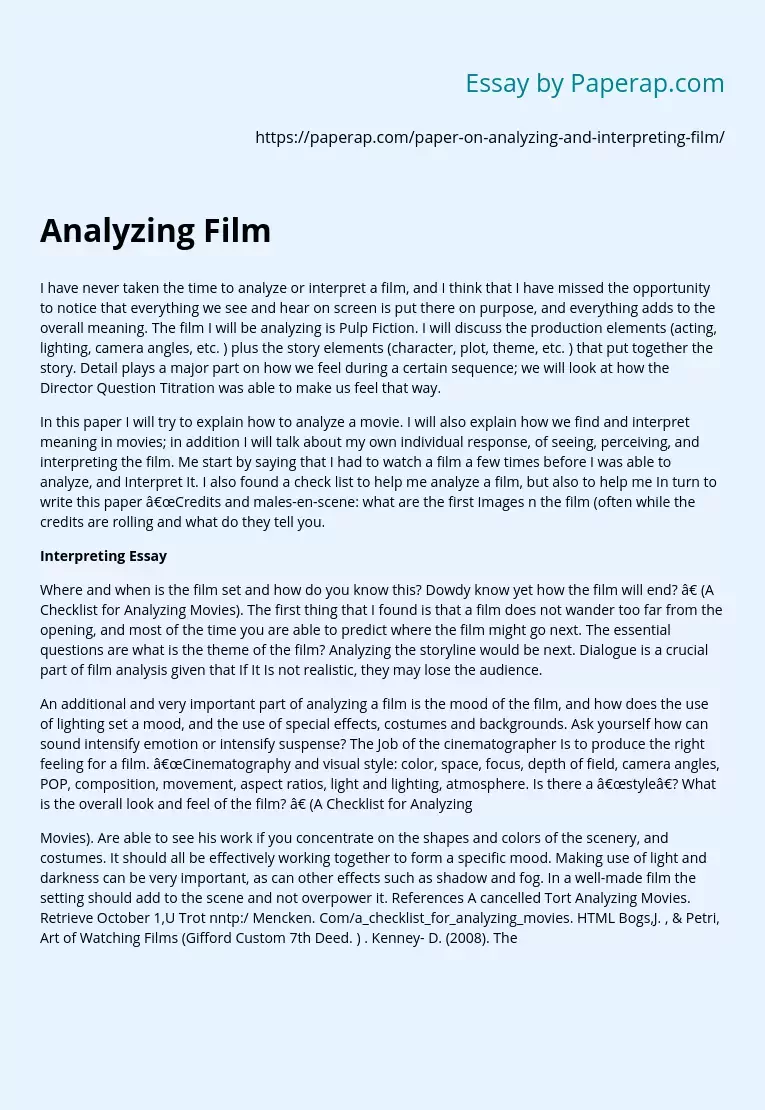The Importance of Analyzing Films
I have never taken the time to analyze or interpret a film, and I think that I have missed the opportunity to notice that everything we see and hear on screen is put there on purpose, and everything adds to the overall meaning. The film I will be analyzing is Pulp Fiction. I will discuss the production elements (acting, lighting, camera angles, etc. ) plus the story elements (character, plot, theme, etc. ) that put together the story. Detail plays a major part on how we feel during a certain sequence; we will look at how the Director Question Titration was able to make us feel that way.
In this paper I will try to explain how to analyze a movie. I will also explain how we find and interpret meaning in movies; in addition I will talk about my own individual response, of seeing, perceiving, and interpreting the film. Me start by saying that I had to watch a film a few times before I was able to analyze, and Interpret It.
I also found a check list to help me analyze a film, but also to help me In turn to write this paper “Credits and males-en-scene: what are the first Images n the film (often while the credits are rolling and what do they tell you.
Interpreting Essay
Where and when is the film set and how do you know this? Dowdy know yet how the film will end? ” (A Checklist for Analyzing Movies). The first thing that I found is that a film does not wander too far from the opening, and most of the time you are able to predict where the film might go next.
The essential questions are what is the theme of the film? Analyzing the storyline would be next. Dialogue is a crucial part of film analysis given that If It Is not realistic, they may lose the audience.
An additional and very important part of analyzing a film is the mood of the film, and how does the use of lighting set a mood, and the use of special effects, costumes and backgrounds. Ask yourself how can sound intensify emotion or intensify suspense? The Job of the cinematographer Is to produce the right feeling for a film. “Cinematography and visual style: color, space, focus, depth of field, camera angles, POP, composition, movement, aspect ratios, light and lighting, atmosphere. Is there a “style”? What is the overall look and feel of the film? ” (A Checklist for Analyzing
Movies). Are able to see his work if you concentrate on the shapes and colors of the scenery, and costumes. It should all be effectively working together to form a specific mood. Making use of light and darkness can be very important, as can other effects such as shadow and fog. In a well-made film the setting should add to the scene and not overpower it. References A cancelled Tort Analyzing Movies. Retrieve October 1,U Trot nntp:/ Mencken. Com/a_checklist_for_analyzing_movies. HTML Bogs,J. , & Petri, Art of Watching Films (Gifford Custom 7th Deed. ) . Kenney- D. (2008). The
The Importance of Analyzing Films. (2019, Dec 05). Retrieved from https://paperap.com/paper-on-analyzing-and-interpreting-film/

